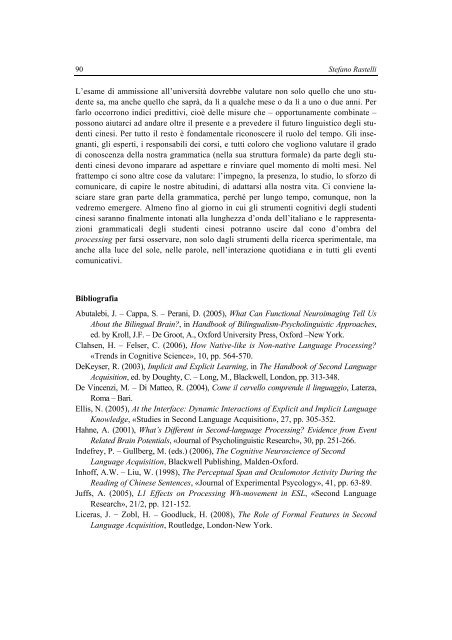La didattica dell'italiano a studenti cinesi e il progetto Marco Polo ...
La didattica dell'italiano a studenti cinesi e il progetto Marco Polo ...
La didattica dell'italiano a studenti cinesi e il progetto Marco Polo ...
Create successful ePaper yourself
Turn your PDF publications into a flip-book with our unique Google optimized e-Paper software.
90<br />
Stefano Rastelli<br />
L’esame di ammissione all’università dovrebbe valutare non solo quello che uno studente<br />
sa, ma anche quello che saprà, da lì a qualche mese o da lì a uno o due anni. Per<br />
farlo occorrono indici predittivi, cioè delle misure che – opportunamente combinate –<br />
possono aiutarci ad andare oltre <strong>il</strong> presente e a prevedere <strong>il</strong> futuro linguistico degli <strong>studenti</strong><br />
<strong>cinesi</strong>. Per tutto <strong>il</strong> resto è fondamentale riconoscere <strong>il</strong> ruolo del tempo. Gli insegnanti,<br />
gli esperti, i responsab<strong>il</strong>i dei corsi, e tutti coloro che vogliono valutare <strong>il</strong> grado<br />
di conoscenza della nostra grammatica (nella sua struttura formale) da parte degli <strong>studenti</strong><br />
<strong>cinesi</strong> devono imparare ad aspettare e rinviare quel momento di molti mesi. Nel<br />
frattempo ci sono altre cose da valutare: l’impegno, la presenza, lo studio, lo sforzo di<br />
comunicare, di capire le nostre abitudini, di adattarsi alla nostra vita. Ci conviene lasciare<br />
stare gran parte della grammatica, perché per lungo tempo, comunque, non la<br />
vedremo emergere. Almeno fino al giorno in cui gli strumenti cognitivi degli <strong>studenti</strong><br />
<strong>cinesi</strong> saranno finalmente intonati alla lunghezza d’onda dell’italiano e le rappresentazioni<br />
grammaticali degli <strong>studenti</strong> <strong>cinesi</strong> potranno uscire dal cono d’ombra del<br />
processing per farsi osservare, non solo dagli strumenti della ricerca sperimentale, ma<br />
anche alla luce del sole, nelle parole, nell’interazione quotidiana e in tutti gli eventi<br />
comunicativi.<br />
Bibliografia<br />
Abutalebi, J. – Cappa, S. – Perani, D. (2005), What Can Functional Neuroimaging Tell Us<br />
About the B<strong>il</strong>ingual Brain?, in Handbook of B<strong>il</strong>ingualism-Psycholinguistic Approaches,<br />
ed. by Kroll, J.F. – De Groot, A., Oxford University Press, Oxford –New York.<br />
Clahsen, H. – Felser, C. (2006), How Native-like is Non-native <strong>La</strong>nguage Processing?<br />
«Trends in Cognitive Science», 10, pp. 564-570.<br />
DeKeyser, R. (2003), Implicit and Explicit Learning, in The Handbook of Second <strong>La</strong>nguage<br />
Acquisition, ed. by Doughty, C. – Long, M., Blackwell, London, pp. 313-348.<br />
De Vincenzi, M. – Di Matteo, R. (2004), Come <strong>il</strong> cervello comprende <strong>il</strong> linguaggio, <strong>La</strong>terza,<br />
Roma – Bari.<br />
Ellis, N. (2005), At the Interface: Dynamic Interactions of Explicit and Implicit <strong>La</strong>nguage<br />
Knowledge, «Studies in Second <strong>La</strong>nguage Acquisition», 27, pp. 305-352.<br />
Hahne, A. (2001), What’s Different in Second-language Processing? Evidence from Event<br />
Related Brain Potentials, «Journal of Psycholinguistic Research», 30, pp. 251-266.<br />
Indefrey, P. – Gullberg, M. (eds.) (2006), The Cognitive Neuroscience of Second<br />
<strong>La</strong>nguage Acquisition, Blackwell Publishing, Malden-Oxford.<br />
Inhoff, A.W. – Liu, W. (1998), The Perceptual Span and Oculomotor Activity During the<br />
Reading of Chinese Sentences, «Journal of Experimental Psycology», 41, pp. 63-89.<br />
Juffs, A. (2005), L1 Effects on Processing Wh-movement in ESL, «Second <strong>La</strong>nguage<br />
Research», 21/2, pp. 121-152.<br />
Liceras, J. − Zobl, H. – Goodluck, H. (2008), The Role of Formal Features in Second<br />
<strong>La</strong>nguage Acquisition, Routledge, London-New York.

















